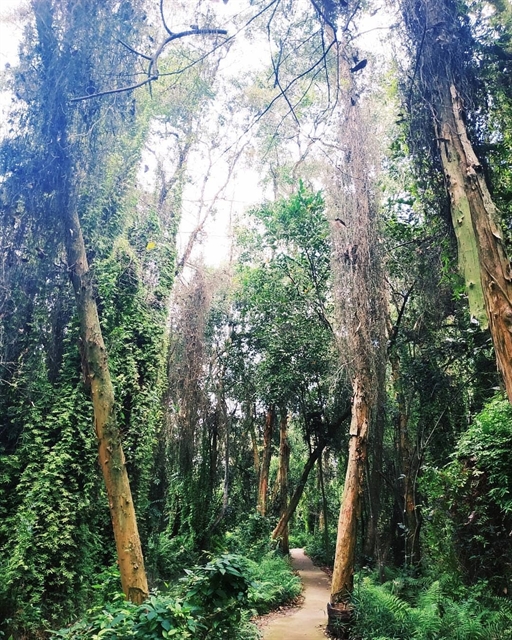[ad_1]

Lâm Thanh
Located about 30km from the centre of Cao Lãnh City, Đồng Tháp Province, in the area of Mỹ Long and Mỹ Hiệp communes, the Xẻo Quýt national historic site, as well as the ecological area, gave us the feeling of being lost in a primaeval forest with beautiful scenery.
In the past, Xẻo Quýt was a wild swamp of weeds and full of creeks and reeds. During 1960-1975, it was chosen as a strategic base of the liberation force in the anti-American war; now, it is not only a historical relic but also one of the unique tourist destinations of the province.
To get here, we went through An Hữu T-junction in Cái Bè District, Tiền Giang Province to Long Hiệp Bridge, then from there, we took a boat to the relic site.
The site has an area of about 50ha, including 20ha of cajuput forest, the rest being mangrove swamp and lianas.
The air here was extremely fresh. We were immersed in the beautiful natural scenery with a cool green colour.
In Xẻo Quýt, you have two ways to move about. If you like to wander under the shade of forest trees, you can walk along the unique path in the site which is about 1.5km long, or you can take a boat to explore the entire rerelic, which is what we did.
The guide, who dressed like a guerrilla with áo bà ba (traditional dress of southern women), khăn rằn (scarf with a checkered pattern), and nón tai bèo (broad-brimmed cap), took us through the pristine creeks to enter the hidden relic in the vast cajuput forest.
It took about 45 minutes to discover the relic with its diverse ecological environment with rich fauna and flora, including about 13 animals in Việt Nam’s Red Data Book.

Xẻo Quýt also has many lotus ponds with giant leaves to take beautiful pictures.
“Coming here, I feel very comfortable. We love the wild nature here. While listening to the songs of birds, the sound of the murmuring water, the music of the forest, I am not only lost in a rich natural area but also relive the scenery of the old resistance zone when witnessing fortifications, bomb shelters and underground hideouts restored to be intact as before,” said tourist Trương Văn Phố.
Tourist Lương Văn Mạnh said he has visited many historical sites but had never seen a place that retained such pristine scenery and cultural and historical values.
The Xẻo Quýt national relic has been preserved and restored to protect the local landscape, nature and environment by provincial authorities.

According to Chung Văn Thanh Hùng, director of Xẻo Quýt national relic site, the relic was a key tourist area of the province as part of efforts to promote the value of heritages associated with tourism development under the Đồng Tháp tourism development project in 2015 – 2020.
“Over the past years, we have constantly improved the quality of human resources, infrastructure, and services and gradually diversified tourism products to attract tourists.
“In particular, all activities here are oriented to the people, including tourism development associated with the community to bring sustainable livelihoods for locals, while contributing to protecting the ecological environment and preserving indigenous culture,” said Hùng.

Tasty food
Xẻo Quýt’s main speciality dish is red rice, which local people say gives one the vitality of a dragon.
In addition, other dishes lẩu cá linh bông điên điển (linh fish hot pot with sesban flowers), gỏi sen (a salad of lotus stems, shrimp and herbs), cá lóc nướng cuộn lá sen non (grilled snakehead fish rolled in young lotus leaf) and cá diêu hồng chiên xù (fried red tilapia) are worth trying.
After visiting the historical site, we also visited the typical southern markets and famous craft villages around this area, listened to the melodious chanteys and the music of đờn ca tài tử (southern folk music) on the river. — VNS
[ad_2]
Source link
